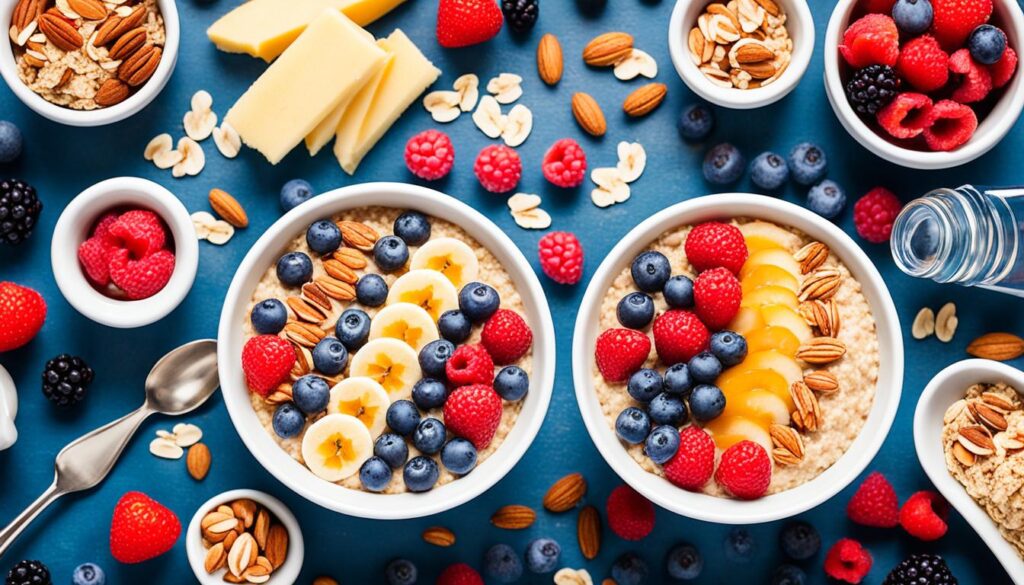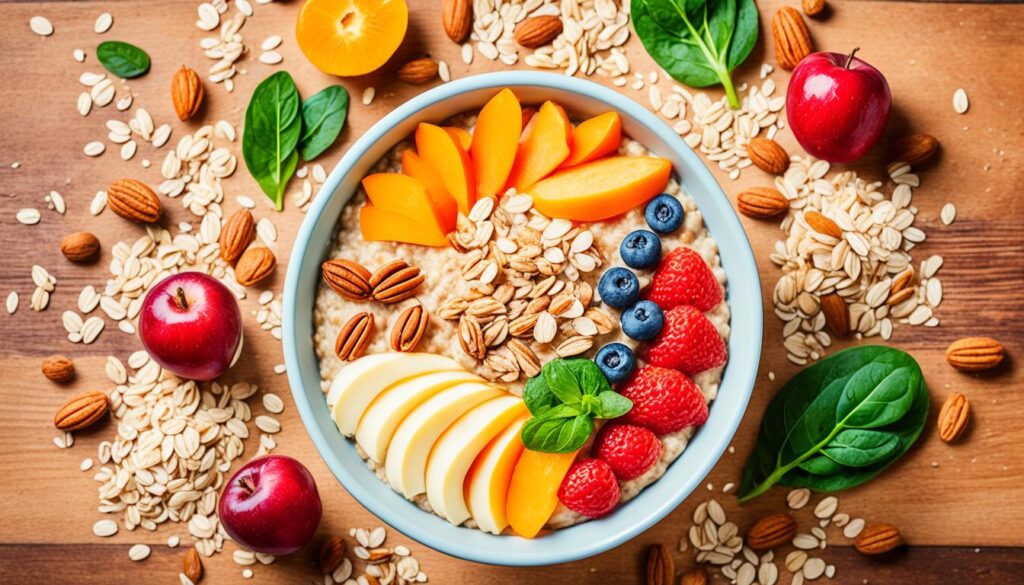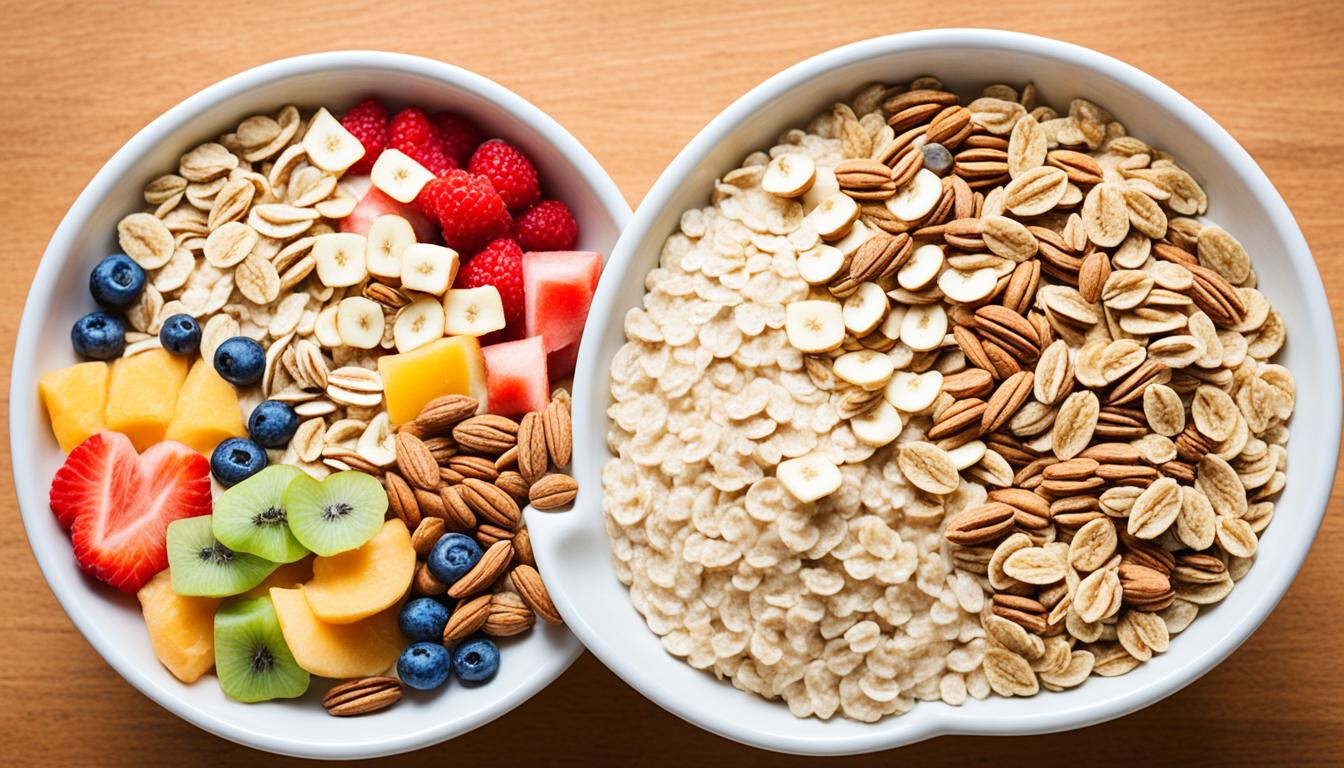Checking oatmeal’s calories is important for dieters. It’s also important for any person who wants a healthy breakfast. Oatmeal is full of nutrients, and it’s great for people who run or are otherwise active, according to nutritionist Blatner. She advises eating a half cup of dry oats. That’s about 50 calories. This keeps breakfast from becoming too high in calories.
In fact, what’s added to oatmeal can really change its nutrition. For example, a serving of nuts or one to two tablespoons of nut butter is perfectly acceptable. Dried fruits have about eight times more calories than fresh ones since they are dehydrated. Secondly, by being careful about toppings used, you can keep your oatmeal at or near 300 to 400 calories and really have a good-tasting meal without blowing your calorie count.
Nutritional Overview of Oatmeal
Oatmeal is a fantastic source of nutrition with a variety of essential nutrients. It’s packed with complex carbs and fiber like beta-glucan. This combination slows digestion, keeping you full longer.
Macro and Micronutrients
A single serving of oatmeal has 95 calories, 5 grams of protein, and 3 grams of fat. It also includes 27 grams of carbs, 4 grams of fiber, and just 1 gram of sugar. A 1/2 cup of dry oatmeal offers slightly more calories at 140, with 2.5 grams of fat and no sodium. It also contains 28 grams of carbs, 4 grams of fiber, no sugar, and 5 grams of protein.
Oatmeal’s glycemic index stands at 57, with a glycemic load of 11. This means it has a moderately low effect on blood sugar3.
Vitamins and Minerals
Oatmeal provides important nutrients such as manganese, molybdenum, and phosphorus. It also has copper, biotin, and Vitamin B1 (Thiamine). These are crucial for supporting your body’s functions.
It doesn’t stop there. Oatmeal also offers manganese, iron, magnesium, zinc, and selenium. This rich blend of vitamins and minerals emphasizes it’s nutritional worth.
Oatmeal is safe for those who avoid gluten, as long as it’s certified gluten-free. This precaution prevents cross-contamination, protecting those with gluten issues. Knowing these oatmeal nutrition facts can guide oatmeal dieters to healthier choices.
Standard Serving Size for Oatmeal and Its Caloric Content
Learning about oatmeal serving sizes and calories is key for a healthy diet. Half a cup of dry rolled oats is about 150 calories. This becomes one cup when cooked. It’s a good meal choice that supports an active life or a nutritious breakfast. It avoids too many calories.
Recommended Serving Sizes
It’s best to mix one part oats with two parts water for rolled oats. For steel-cut oats, use one part oats and three parts water1. This gets the right texture and keeps calories in check. Going for a one-cup serving of cooked oats, about 140 calories, helps manage what you eat.
Impact of Serving Size on Caloric Intake
Serving sizes significantly influence calorie intake. Eating more than a cup of oatmeal can add too many calories. This could mess with staying on track for weight loss. A bowl of oatmeal should have 300 to 400 calories for enough energy without overdoing it. Watch out for high-calorie add-ons like dried fruit.
Knowing how much oatmeal to eat and its calories is very important. By sticking to the serving size tips, people can enjoy oatmeal’s health benefits. They perform this action without risk. This way, they won’t eat too much.
How Many Calories in Bowl of Oatmeal?
Oatmeal is a popular breakfast because it’s full of nutrients and easy to make. One serving of dry rolled oats, equal to a half-cup, contains about 150 calories. It’s important to measure the oats right and watch the amount of liquid you use. For rolled oats, you usually mix one part of oats with two parts of liquid.
Toppings boost oatmeal’s calorie count. To keep it balanced, stick to fresh fruits, nuts, or nut butter. These are healthy but high in calories, so use them sparingly. Careful toppings keep your oatmeal to 300 to 400 calories. It’s a satisfying breakfast. Also, choose unsweetened milk over sweetened ones to avoid extra sugar and calories.
The kind of oats you pick also affects calorie count. Steel-cut oats are more filling but take longer to cook than rolled oats, which are ready in minutes. Instant oatmeal often has lots of added sugar. This makes it high in calories and less filling than plain oats.
To add flavor without calories, try cinnamon, unsweetened cocoa, or vanilla extract. These add great taste without the sugar load. Select your toppings and oats carefully to savor a nutritious oatmeal bowl. It’s going to be nutritious and low in calories.
Added Ingredients and Their Caloric Impact
Oatmeal tastes great with various additions. Yet, these can change its calories and nutrition. Knowing how each ingredient affects oatmeal helps balance taste and health.
Common Sweeteners
Sweeteners like honey and brown sugar add lots of calories. A tablespoon of honey has about 64 calories. Brown sugar adds around 52 calories.
Fruits and Nuts Additions
Adding fruits can make oatmeal more nutritious without too many calories. Berries, for instance, add sweetness and vitamins with few calories. But dried fruits, like raisins, have lots of calories from sugar and should be limited.
Nut butters and whole nuts add protein and healthy fats. Yet, they’re high in calories too. For example, almond butter has about 98 calories per tablespoon. It’s important to watch how much you use.
Effect of Dairy and Non-Dairy Milks
The type of milk you use in oatmeal changes its calories. Whole milk adds about 150 calories per cup. Skim milk adds around 90 calories. Almond milk, a non-dairy choice, has just about 30 calories per cup. Choosing unsweetened milk helps keep calories low.
Oatmeal is good for you thanks to its fiber and protein. But what you add to it is key. Smart choices in toppings and mix-ins keep oatmeal healthy and tasty.
Types of Oats and Their Caloric Differences
Understanding the different oats and their nutrients helps us choose well. Rolled oats, steel-cut oats, and instant oats have similar calories. Yet, they offer varied textures and cook times.
Rolled Oats vs. Steel Cut Oats
Rolled oats are steamed and flattened. They pack 150 calories, 5 grams of protein, and 4 grams of fiber per 40g serving. With 0 grams of sugar, they are great for blood sugar management. A 40g serving also provides valuable minerals and vitamins.
Steel-cut oats are a bit firmer and take 20-30 minutes to cook. They share similar nutrition to rolled oats but have less added sugars.
Instant Oats and Their Nutritional Value
Instant oats cook in minutes, ideal for a quick meal. They contain 148 calories and about 5.5 grams of protein per 40g serving. Even with added sugars, they’re a fibrous option.
Despite being highly processed, instant oats remain whole grain. Eating different types supports heart health and adds variety to meals.
Health Benefits of Oatmeal
People love oatmeal for its great nutrition and health perks. It has key nutrients and fiber, which improves heart, blood sugar, and digestive health.
Oatmeal and Heart Health
Oatmeal boosts heart health with its soluble fiber, beta-glucan. This fiber lowers bad cholesterol. It cuts heart disease risk by stopping cholesterol buildup and oxidation. A study found a 23% drop in cholesterol in those who ate oat bran. Oats have antioxidants, like avenanthramides, that make blood flow and less inflammation.
Benefits for Blood Sugar Levels
Oats are great for controlling blood sugar because they have a low glycemic index. The beta-glucan in oats stabilizes glucose and insulin after eating. It helps those with diabetes. It’s also lowers blood sugar and boosts good gut bacteria. Studies show that oats can prevent type 2 diabetes.
Contribution to Digestive Health
Oatmeal, rich in dietary fiber, supports a healthy digestive system. Its mixed fibers aid gut health and bowel movement. Beta-glucan in oats fosters good gut bacteria, enhancing digestive well-being. Oat bran helps with constipation and digestive issues. It aids those with ulcerative colitis. Oatmeal consumption enhances digestive processes and promotes general well-being.

Oatmeal as a Weight Loss Aid
Oatmeal is great for losing weight because it’s full of good nutrients. A half cup of dry oats is rich in essential stuff. This stuff includes manganese, phosphorus, magnesium, copper, iron, and zinc. It also has folate, and vitamins B1 and B5.
When you cook a cup of oatmeal, it has 27.4g of carbohydrates, 5.3g of protein, 2.6g of fat, 4g of fibre, and 153.5 calories. Oats have beta-glucan, a kind of fibre that lowers blood sugar and helps you feel full. This is great for people with diabetes and those who want to eat less during the day.
Oatmeal helps with weight control by being low in calories but filling. Eating oats often can help reduce body weight, fat, and even your waist size over 12 weeks. It’s a smart option for anyone trying to lose weight because it makes you feel full with fewer calories.
The protein and fiber in oatmeal make it a hearty meal. With 10 grams each of protein and fiber in a cup of rolled oats, it supports weight goals and keeps muscle mass up. Adding oatmeal to a balanced diet helps keep your nutrition up while managing weight.
In a nutshell, oatmeal is a powerhouse for those wanting to shed pounds. It’s low in calories but high in fiber and protein, helping you stay full and eat less. It’s also packed with nutrients, making it an ideal part of a healthy diet.
How to Enhance the Nutritional Value of Oatmeal
Making your oatmeal more nutritious is easy. Add a variety of wholesome ingredients to boost its goodness. This won’t make your meal much higher in calories. Putting in fresh fruits adds great flavor and important vitamins and minerals. For example, blueberries are a great source of antioxidants.

Adding nuts, such as almonds or walnuts, adds healthy fats and proteins. This makes your oatmeal more filling. A half-cup of dry oats has 5.3 grams of protein and 2.6 grams of fat. Nuts can increase these amounts. Also, spices like cinnamon make it’s tasty without extra calories. This creates a delicious and healthy meal.
Use unsweetened milk options like almond or oat milk to keep sugar and calories low. Choosing unsweetened liquids stops extra sugar from sneaking into your meal. A cup of oatmeal, made with water, has 153.5 calories, 4 grams of fiber, and 27.4 grams of carbs. That’s good for your diet.
Adding fiber-rich fruits and nuts increases the meal’s fiber, vitamins, and minerals. Each serving of oatmeal has 4 grams of fiber for better digestion and fullness. Toppings like chia seeds or flaxseeds add more fiber and omega-3s.
Choosing the right ingredients can easily make your oatmeal healthier. It’s become a more complete and satisfying meal.
Conclusion
Oatmeal is a key food for anyone focusing on their health. It’s filled with nutrients like dietary fiber. This makes it great for improving digestion. It also helps with managing weight or boosting diet quality. Oats also have beta-glucan fiber. It lowers bad cholesterol without hurting good levels. Plus, oatmeal is packed with antioxidants and important minerals like iron and magnesium. This makes it a vital part of a healthy diet.
Knowing the calories in oatmeal helps people match it to their diet goals. A cup of dry oats has around 297 calories. Half a cup of raw dry oats, about 45 grams, has between 140 and 200 calories, depending on what you add. Changes to preparation and ingredients reshape calorie and benefit counts. Choosing unsweetened fruits, nuts, and non-dairy milk can boost oatmeal’s nutrition. It’s not adding calories.
Eating oatmeal often helps you feel full, manage your weight, and gives you energy all day. It’s a whole grain, reducing colorectal cancer risk by 10% for every extra 10 grams of fiber you eat daily. The food industry offers many oat-based products. These include cereals and snacks that meet today’s dietary needs.
Oatmeal is a wise choice for a healthy diet, adaptable for various wellness goals. You can choose rolled, steel-cut, or instant oats. Then, add healthy ingredients. This turns oatmeal into a tasty, nutritious option for any diet.








